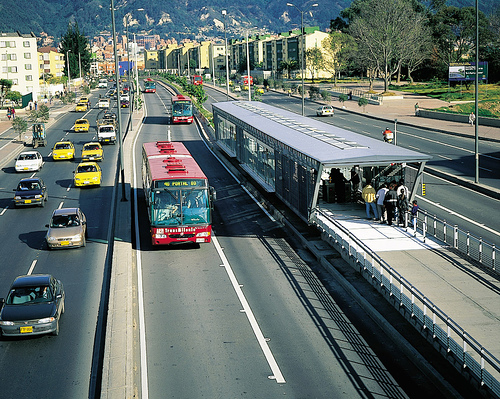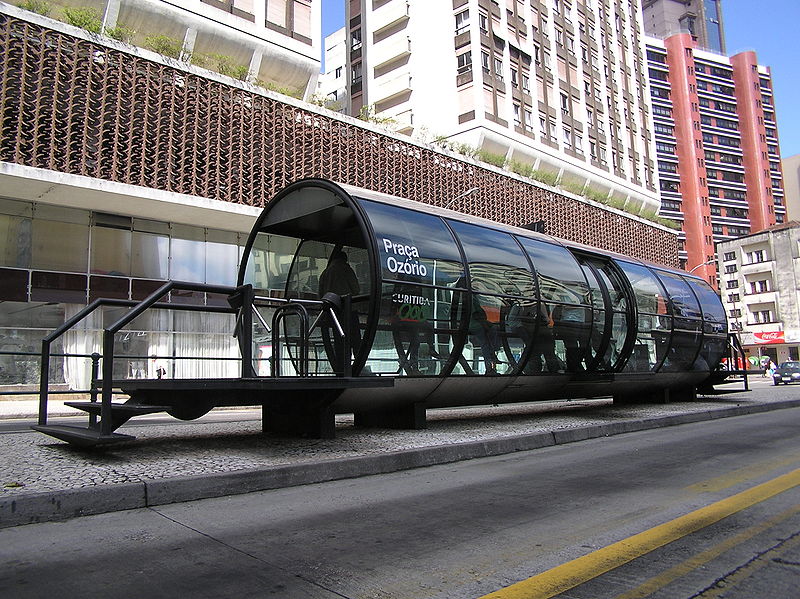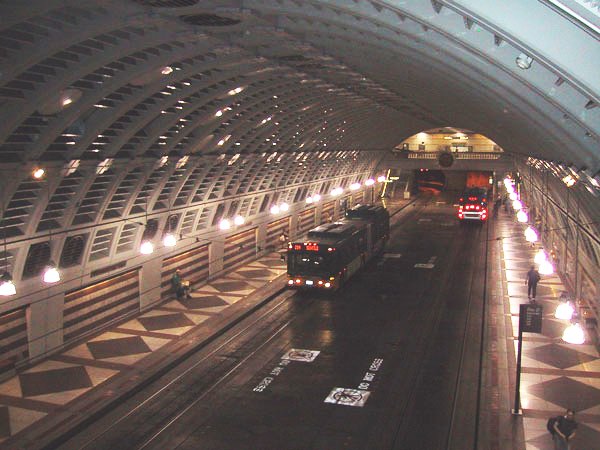This article was scraped from Rochester Subway. This is a blog about Rochester history and urbanism has not been published since 2017. The current owners are now publishing link spam which made me want to preserve this history.. The original article was published April 07, 2009 and can be found here.

If I said Rochester may one day have a rapid transportation system linking RIT to downtown Rochester and beyond, you might automatically think 'light rail'. Think again. RochesterSubway.com recently discussed the future of Rochester's transportation infrastructure with Richard Perrin, Executive Director of the Genesee Transportation Council and an AICP certified city planner.
NOTE: If you've got a question that we didn't ask in our interview, please leave a comment at the end of this post and we'll pass it along to Mr. Perrin who will do his best to answer it as time permits.
ROCHESTERSUBWAY.COM: Do you feel our current system of highways, bus routes, etc. are adequate to serve the needs and growth of our community moving into the future?
MR. PERRIN: Based on the Long Range Transportation Plan for the Genesee-Finger Lakes Region: 2007-2027 Update , the capacity of the current highway and bridge network will continue to be adequate to support the travel of persons and freight associated with the increases in population and employment that are forecasted for the region (as determined by historical trends) over the next 20 years. Existing areas of congestion will gradually expand during the peak periods (i.e., the morning and evening rush hours) if nothing is done but much of this can be mitigated (or even eliminated) through highly cost-effective investments in Intelligent Transportation System (ITS) technologies and Travel Demand Management activities.
ROCHESTERSUBWAY.COM: What do you think mass-transit in Rochester NY should look like in 2020? Specifically, what would you like to see changed or upgraded?
MR. PERRIN: Public transportation in the region should not only provide mobility and accessibility for persons without the ability to operate or access a private automobile but also serve as an attractive option for the discretionary rider. The form this takes will be dictated by the demands placed on the system by future development patterns and the resources available to provide public transportation services. The Regional Transit Service (RTS) operated by the Rochester Genesee Regional Transportation Authority (RGRTA) in Monroe County has seen significant increases in ridership (approximately 20 percent between October 2007 and October 2008). Ultimately, the decisions that shape the public transportation system over the next 10 to 12 years will be based on an on-going analysis of current and likely future development (both redevelopment and new development) and the associated needs and desires to utilize the services of this system.
ROCHESTERSUBWAY.COM: As the City of Rochester works to implement its long term vision for the center city, what are some lessons from our past that we can build on?
MR. PERRIN: There are a number of lessons that we can learn from not only the past but also the present. There are approximately 50,000 employees who work inside the Inner Loop (the Rochester Central Business District or CBD). This represents approximately one out of every 10 jobs in the 4,700-square mile nine-county region. The hub-and-spoke system employed by RTS provides a competitive advantage and reinforces the Rochester CBD as the geographical mainstay of the region. The City of Rochester, Monroe County, and RGRTA have carefully assessed these factors and incorporated them into future development in the Rochester CBD through Renaissance Square, the Broad Street Corridor Master Plan, and other activities.
ROCHESTERSUBWAY.COM: In your opinion, is there a future for local, rail-based transportation (i.e., trolleys, streetcars, light rail, subway, etc.) within Rochester and it's suburbs?
MR. PERRIN: There are two key points here:
1. Assuming that rail-based public transportation is the best future option for Rochester and its suburbs is just that: an assumption. Numerous factors determine what the optimal facilities to comprise a regional transportation network are, and costs (both capital and operating) are a primary consideration. There is another "fixed guideway" option: Bus Rapid Transit which is less costly and more flexible than rail-based options. In addition, improving current bus operations through ITS via signal prioritization and advanced traveler information systems for RTS buses is being evaluated and implemented to varying degrees right now.
2. At present, the current programs of the U.S. Department of Transportation (USDOT) typically allow for up to 80 percent of the total cost of a highway or bridge project (replacement of existing or construction of new) to be funded by the Federal Highway Administration (FHWA). FTA administers the New Starts program for fixed guideway systems. This program typically requires a non-federal (local/state) share of 50 percent of the project costs even though the enabling legislation allows for up to 80 percent to be federal - this is because funds from the New Starts program are awarded on a competitive basis and the amount allocated to the program is significantly less than the amount of interest from agencies across the nation (many of whom are expanding existing fixed guideway systems). As a note, this community supplements Federal Transit Administration (FTA) funding dedicated to RTS with FHWA funds in recognition that USDOT does not provide enough funds to sustain, much less improve, our existing system.
The introduction of light rail in this community is not financially feasible at this time given the multitude of issues facing the community that require public resources, the overall resistance to additional local and state taxes and fees, and the fact that the local/state share for the construction costs of a light rail system (not including the on-going operating and maintenance costs) would be, at a minimum, approximately $12.5 million per mile (50 percent of the total cost at $25 million per mile).
With that said, GTC continues to assess the potential of high-capacity corridors in the region to determine the viability of implementing cost-effective fixed guideway public transportation services in coordination with associated transit oriented development. We do this because opportunities may arise in the future that would make a fixed guideway system cost-effective such as changes in USDOT funding policies, current development patterns, and personal travel preferences.
ROCHESTERSUBWAY.COM: What would be an example of a corridor in our area that would be a candidate for a fixed guideway system? What destinations might be connected?
MR. PERRIN: GTC has identified Commuter Corridors for the Rochester Transportation Management Area (see CommuterCorridors.pdf ), which includes all of Monroe County and the surrounding areas to the south and east in Livingston, Ontario, and Wayne Counties. The most prominent one at present would be a subset of Commuter Corridor 8 from, at a minimum, the University of Rochester to Downtown Rochester with consideration of extending the line south through portions of Brighton to the Rochester Institute of Technology and potentially north to the Port of Rochester/Charlotte.
It cannot be stressed enough that a single fixed guideway corridor would not be a sufficient investment. If the community were to commit to implementing fixed guideway transit, it would have to be a commitment to a system that would connect our multiple activity centers, including [points downtown, GRI Airport, Charlotte, etc.].
ROCHESTERSUBWAY.COM: If Rochester were to implement RBT, what are some other cities that might serve as a role model for that system?

Perrin: Bus Rapid Transit (BRT) is still a fairly new fixed guideway option but a few examples offer some insights as to its effectiveness and, potentially, its pitfalls. The two most extensively cited examples are in South America: the Transmilenio in Bogota, Columbia and the Curitiba, Brazil BRT system . However, there are marked differences between factors affecting transportation mode choice in these areas and Rochester, New York - namely, private vehicle ownership.

In the U.S., Albany NY , Hartford CT , and Eugene OR , are some of the projects that may be suitable comparisons. However, every area is unique and success or failure in another part of the country may not be indicative of the benefits/impacts of implementing BRT (or any other fixed guideway system) here.
Also, it is extremely important to note that BRT proponents/advocates often state that BRT is Light Rail Transit (LRT), only cheaper. It is my opinion that this is not entirely accurate. Even with off-board fare collection, next-stop bus technology, dedicated rights-of-way, level boarding platforms, and signal preemption, there are two distinct differences: 1.) BRT does not provide the same level of physical permanence as LRT for surrounding development and 2.) the actual BRT ride itself is not of the same experience as LRT.
This is not to say that one is superior to the other, only that they are not the exact same and should not be viewed as such. They are two options on a spectrum ranging from demand-responsive bus service to heavy commuter rail. Cost (both capital and operating) is obviously a consideration when making decisions with public funds (i.e., taxpayers' money) and the differences need to be recognized and accounted for in the evaluation of alternatives.
ROCHESTERSUBWAY.COM: Finally, what would you say to the Rochesterian with an "if you build it they will come" mindset? Those who say that a subway/light-rail system connecting the brightest spots in Rochester (East End, Cornhill, Park Ave, etc.) together with key points in our region (Pittsford, Canandaigua, GRI Airport, etc.) would jumpstart growth, and in the long run pay for itself?
MR. PERRIN: My response would be the same as to those that claim that new highways do not effectively improve mobility in the long-term and induce additional single-occupancy vehicle demand: transportation planning and the resulting investments are most effective and yield the largest benefits when they are coordinated with land use planning.
Why build it and hope they will come when you can implement the transportation investment(s) in concert with land use regulation changes and development incentives that secure private development commitments (to the greatest extent possible) simultaneously?
As for paying for itself, any form of transportation that does this (or comes reasonably close) would be provided for by private entities. The fact is that all forms of transportation require some level and form of public subsidy because they provide a public good. The consideration that needs to be continually reviewed is what level and form of public subsidy is appropriate, and much of this is dictated by policy directives at the federal level.


